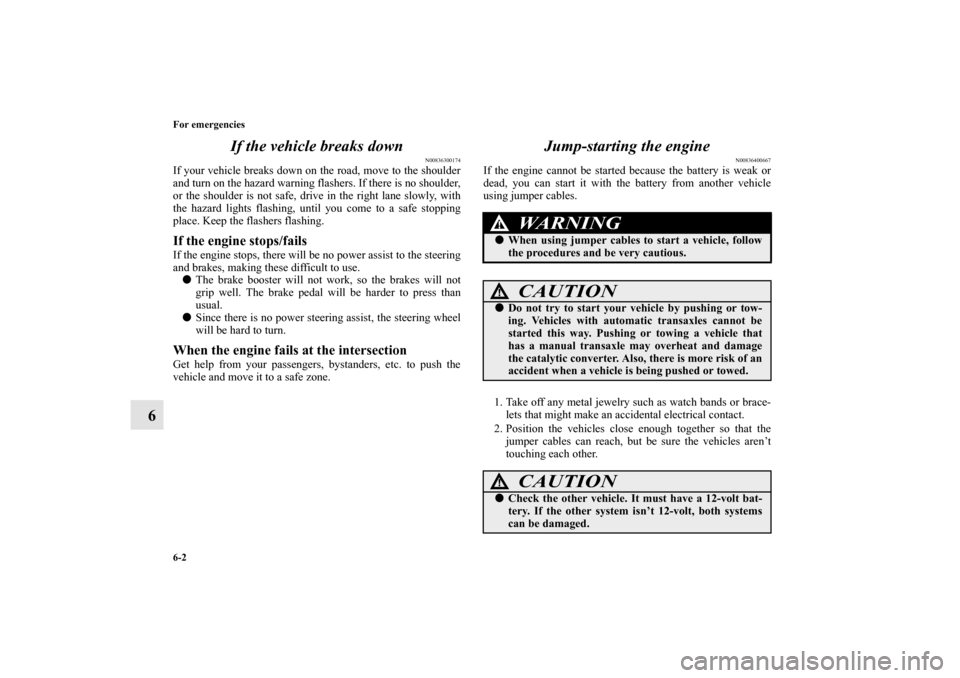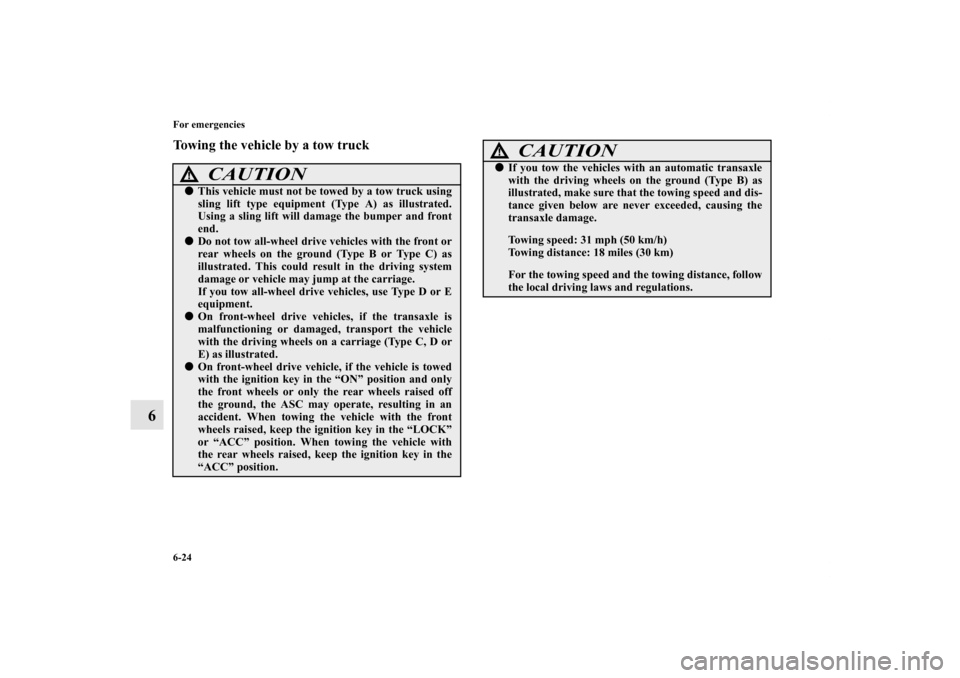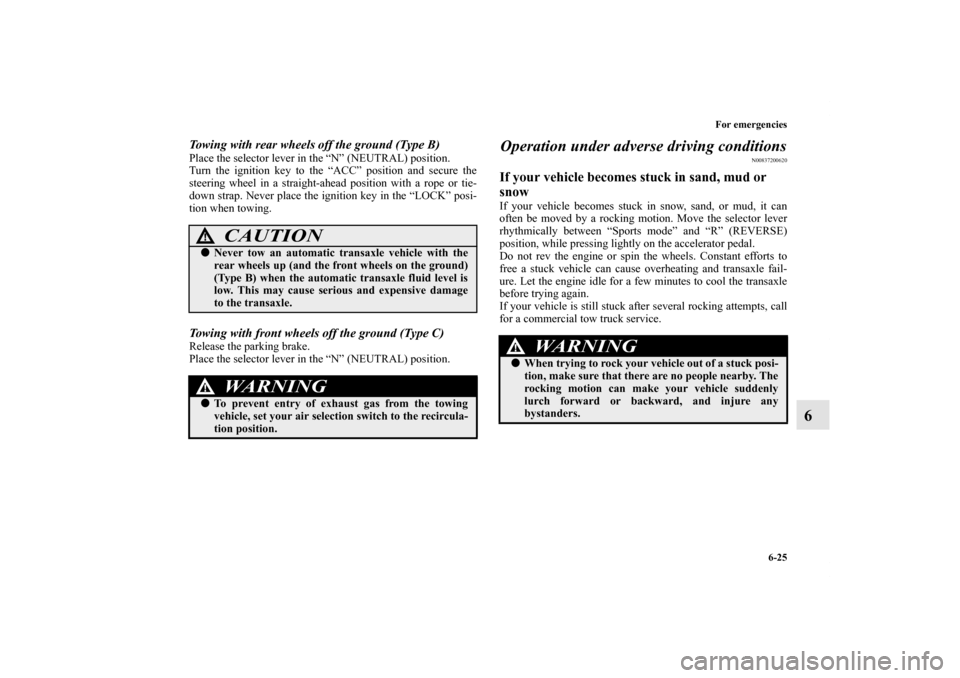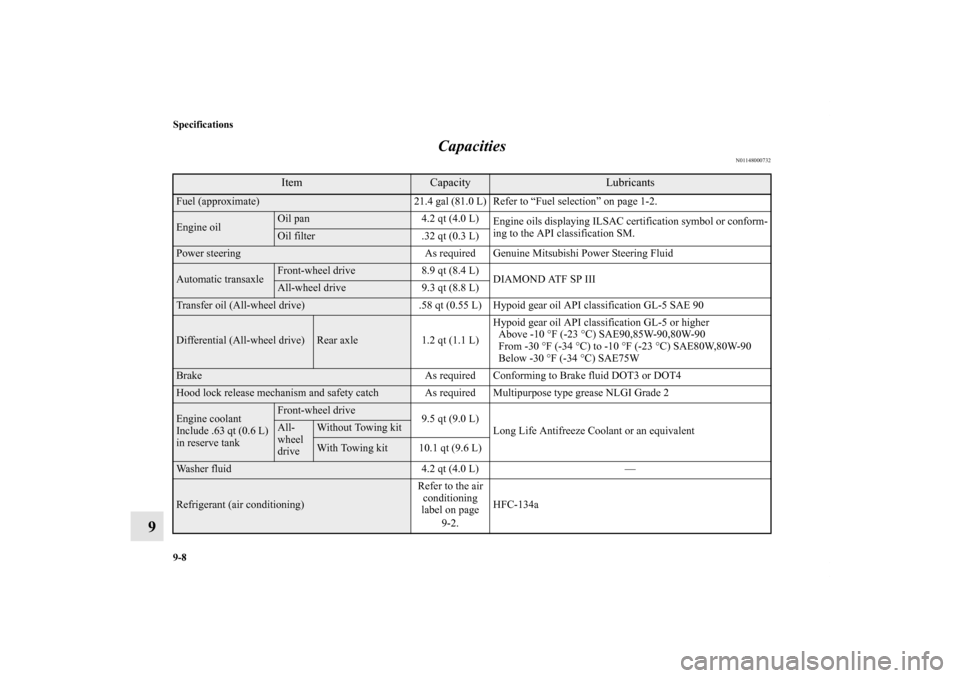Page 401 of 514

6-2 For emergencies
6If the vehicle breaks down
N00836300174
If your vehicle breaks down on the road, move to the shoulder
and turn on the hazard warning flashers. If there is no shoulder,
or the shoulder is not safe, drive in the right lane slowly, with
the hazard lights flashing, until you come to a safe stopping
place. Keep the flashers flashing. If the engine stops/fails If the engine stops, there will be no power assist to the steering
and brakes, making these difficult to use.
�The brake booster will not work, so the brakes will not
grip well. The brake pedal will be harder to press than
usual.
�Since there is no power steering assist, the steering wheel
will be hard to turn.When the engine fails at the intersection Get help from your passengers, bystanders, etc. to push the
vehicle and move it to a safe zone.
Jump-starting the engine
N00836400667
If the engine cannot be started because the battery is weak or
dead, you can start it with the battery from another vehicle
using jumper cables.
1. Take off any metal jewelry such as watch bands or brace-
lets that might make an accidental electrical contact.
2. Position the vehicles close enough together so that the
jumper cables can reach, but be sure the vehicles aren’t
touching each other.
WA R N I N G
!�When using jumper cables to start a vehicle, follow
the procedures and be very cautious.
CAUTION
!�Do not try to start your vehicle by pushing or tow-
ing. Vehicles with automatic transaxles cannot be
started this way. Pushing or towing a vehicle that
has a manual transaxle may overheat and damage
the catalytic converter. Also, there is more risk of an
accident when a vehicle is being pushed or towed.
CAUTION
!�Check the other vehicle. It must have a 12-volt bat-
tery. If the other system isn’t 12-volt, both systems
can be damaged.
BK0121600US.book 2 ページ 2010年4月12日 月曜日 午前10時39分
Page 422 of 514
For emergencies
6-23
6 To w i n g
N00837000703
If your vehicle needs to be towedIf towing is necessary, we recommend you to have it done by a
commercial tow truck service.
When towing is required, transport the vehicle using a tow
truck.
Incorrect towing equipment could damage your vehicle.
There may be local regulations concerning towing in your area.
Obey the regulations of the area where you are driving your
vehicle.
CAUTION
!�Do not attempt to be towed by another vehicle with
a rope.
Do not tow all-wheel drive vehicles with this style.
Do not tow all-wheel drive vehicles with this style.
BK0121600US.book 23 ページ 2010年4月12日 月曜日 午前10時39分
Page 423 of 514

6-24 For emergencies
6
Towing the vehicle by a tow truck
CAUTION
!�This vehicle must not be towed by a tow truck using
sling lift type equipment (Type A) as illustrated.
Using a sling lift will damage the bumper and front
end.�Do not tow all-wheel drive vehicles with the front or
rear wheels on the ground (Type B or Type C) as
illustrated. This could result in the driving system
damage or vehicle may jump at the carriage.
If you tow all-wheel drive vehicles, use Type D or E
equipment.�On front-wheel drive vehicles, if the transaxle is
malfunctioning or damaged, transport the vehicle
with the driving wheels on a carriage (Type C, D or
E) as illustrated.�On front-wheel drive vehicle, if the vehicle is towed
with the ignition key in the “ON” position and only
the front wheels or only the rear wheels raised off
the ground, the ASC may operate, resulting in an
accident. When towing the vehicle with the front
wheels raised, keep the ignition key in the “LOCK”
or “ACC” position. When towing the vehicle with
the rear wheels raised, keep the ignition key in the
“ACC” position.
�If you tow the vehicles with an automatic transaxle
with the driving wheels on the ground (Type B) as
illustrated, make sure that the towing speed and dis-
tance given below are never exceeded, causing the
transaxle damage.
Towing speed: 31 mph (50 km/h)
Towing distance: 18 miles (30 km)
For the towing speed and the towing distance, follow
the local driving laws and regulations.
CAUTION
!
BK0121600US.book 24 ページ 2010年4月12日 月曜日 午前10時39分
Page 424 of 514

For emergencies
6-25
6
Towing with rear wheels off the ground (Type B)Place the selector lever in the “N” (NEUTRAL) position.
Turn the ignition key to the “ACC” position and secure the
steering wheel in a straight-ahead position with a rope or tie-
down strap. Never place the ignition key in the “LOCK” posi-
tion when towing.Towing with front wheels off the ground (Type C)Release the parking brake.
Place the selector lever in the “N” (NEUTRAL) position.
Operation under adverse driving conditions
N00837200620
If your vehicle becomes stuck in sand, mud or
snow If your vehicle becomes stuck in snow, sand, or mud, it can
often be moved by a rocking motion. Move the selector lever
rhythmically between “Sports mode” and “R” (REVERSE)
position, while pressing lightly on the accelerator pedal.
Do not rev the engine or spin the wheels. Constant efforts to
free a stuck vehicle can cause overheating and transaxle fail-
ure. Let the engine idle for a few minutes to cool the transaxle
before trying again.
If your vehicle is still stuck after several rocking attempts, call
for a commercial tow truck service.
CAUTION
!�Never tow an automatic transaxle vehicle with the
rear wheels up (and the front wheels on the ground)
(Type B) when the automatic transaxle fluid level is
low. This may cause serious and expensive damage
to the transaxle.
WA R N I N G
!�To prevent entry of exhaust gas from the towing
vehicle, set your air selection switch to the recircula-
tion position.
WA R N I N G
!�When trying to rock your vehicle out of a stuck posi-
tion, make sure that there are no people nearby. The
rocking motion can make your vehicle suddenly
lurch forward or backward, and injure any
bystanders.
BK0121600US.book 25 ページ 2010年4月12日 月曜日 午前10時39分
Page 502 of 514

Specifications
9-5
9 Vehicle weights
N01147600728
NOTE�Roof load is important because it affects the vehicle capacity weight. Refer to “Loading cargo on the roof” on page 4-13.
GVWR: maximum total weight (load) limit specified for the vehicle
GAWR: maximum weight (load) limit specified for the front or rear axle
Seating capacity: the number of maximum occupants
Item
FWD
AW D
Gross vehicle weight rating 5,159 lb (2,340 kg) 5,346 lb (2,425 kg)Gross axle weight
rating
Front 2,745 lb (1,245 kg)Rear 2,800 lb (1,270 kg)
Gross combination weight rating 8,309 lb (3,769 kg) 8,496 lb (3,854 kg)Total trailer weight
Without Towing kit
Trailer without brake 1,500 lb (680 kg)Trailer with brake 2,000 lb (907 kg)
With Towing kit
Trailer without brake 1,500 lb (680 kg)Trailer with brake 3,500 lb (1,588 kg)
Vehicle capacity weight 970 lb (440 kg)Maximum roof load
Without crossbars
Vehicles with
17 inch tires200 lb (91 kg)Vehicles with
18 inch tires100 lb (45 kg)
With crossbars 100 lb (45 kg)
Seating capacity5 persons
BK0121600US.book 5 ページ 2010年4月12日 月曜日 午前10時39分
Page 505 of 514

9-8 Specifications
9Capacities
N01148000732
Item
Capacity
Lubricants
Fuel (approximate) 21.4 gal (81.0 L) Refer to “Fuel selection” on page 1-2.Engine oil
Oil pan 4.2 qt (4.0 L)
Engine oils displaying ILSAC certification symbol or conform-
ing to the API classification SM.Oil filter .32 qt (0.3 L)
Power steering As required Genuine Mitsubishi Power Steering Fluid Automatic transaxle
Front-wheel drive 8.9 qt (8.4 L)
DIAMOND ATF SP III All-wheel drive 9.3 qt (8.8 L)
Transfer oil (All-wheel drive) .58 qt (0.55 L) Hypoid gear oil API classification GL-5 SAE 90Differential (All-wheel drive)
Rear axle 1.2 qt (1.1 L)Hypoid gear oil API classification GL-5 or higher
Above -10 °F (-23 °C) SAE90,85W-90,80W-90
From -30 °F (-34 °C) to -10 °F (-23 °C) SAE80W,80W-90
Below -30 °F (-34 °C) SAE75W
Brake As required Conforming to Brake fluid DOT3 or DOT4 Hood lock release mechanism and safety catch As required Multipurpose type grease NLGI Grade 2 Engine coolant
Include .63 qt (0.6 L)
in reserve tank
Front-wheel drive
9.5 qt (9.0 L)
Long Life Antifreeze Coolant or an equivalentAll-
wheel
drive
Without Towing kitWith Towing kit 10.1 qt (9.6 L)
Washer fluid 4.2 qt (4.0 L) — Refrigerant (air conditioning)Refer to the air
conditioning
label on page
9-2.HFC-134a BK0121600US.book 8 ページ 2010年4月12日 月曜日 午前10時39分
Page 512 of 514

Alphabetical index
7
Timer function 3-24
,3-26
Timing belt 7-34
Tire pressure monitoring system 3-69
Tires 7-20
Compact spare tire 6-14
How to change a tire 6-12
Inflation pressure 7-24
Maintenance 7-26
Quality grading 8-2
Replacing tires and wheels 7-26
Rotation 7-27
Size (tire and wheel) 9-7
Snow tires 7-28
Spare tire information 6-13
Tire and loading information placard 4-9
,9-3
Tire chains 7-29
Tread wear indicators 7-26
Tissue holder 3-204
Tonneau cover 3-208
Tools 6-8
Storage 6-7
Towing 6-23
Trailer towing 4-15
Transfer oil 7-13
,9-8
Trip odometer 3-78
Turn signal light
Bulb capacity 7-45
Indicators 3-83
Lever 3-157Replacement 7-48
,7-51
V
Vanity mirror 3-195
Vehicle care precautions 7-57
Vehicle dimensions 9-4
Vehicle labeling 9-2
Vehicle preparation before driving 4-3
Vehicle weights 9-5
Vents 5-2
W
Warning lights 3-83
Washer
Fluid 7-14
,9-8
Rear window washer 3-161
Switch 3-161
Windshield washer 3-161
Waxing 7-61
Weights 9-5
Wheel
Specification 9-7
Wiper
Rear window wiper 3-161
Switch 3-159
Windshield 3-159
Wiper blades 7-31
BK0121600US.book 7 ページ 2010年4月12日 月曜日 午前10時39分
Page:
< prev 1-8 9-16 17-24